- 86-15907880780
- contact@youngchinatravel.com
Tian'anmen Square, also called the Gate of Heavenly 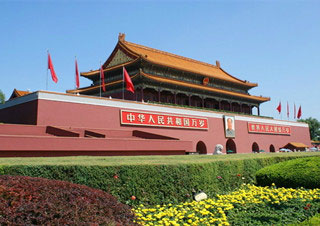 Peace Square, lies in the heart of Beijing. It is 880 meters long from south to north, and 500 meters wide from east to west with the area of 440,000 square meters. As the largest city square in the world, it allows one million people to hold a rally.
Peace Square, lies in the heart of Beijing. It is 880 meters long from south to north, and 500 meters wide from east to west with the area of 440,000 square meters. As the largest city square in the world, it allows one million people to hold a rally.
The Square derives its name from the gate on the north side (Tian’anmen Gate) Reviewing stands have been built at the north end of the Square to accommodate twenty thousand spectators.
The Tian'anmen Square is the site of many official revues and parades on National Holidays. It was from here that the establishment of the People's Republic of China was proclaimed. The square also witnessed the May Fourth Movement and the December Ninth Movement, recording the unyielding revolutionary spirit and undaunted heroic act of Beijing people. After founding of new China, Tian'anmen Square was broadened with more structures built, such as the granite Monument to the People's Heroes at the centre of the square, the Great Hall of the People at the west side, Chinese History Museum and Chinese Revolutionary Museum (merged into China National M) at the east side, and Mao Zedong Memorial Hall at the south side.
The gate consists of five vaulted gate-ways, and in front of each gateway is a marble bridge across a stream called Outer Golden Water River. The bridges are called the Outer Golden Water River Bridges or Marble Bridges. Bridge of the Imperial Way (Yuluqiao 御 路 桥 ) in the mddle is w ider than the other four bridges, and was used in imperial days exclusively by the empe- ror. The two on either side were called Royal Bridge (Wanggongqiao 王 公 桥 )and were used by the imperial relatives. The other two on each side were called Ranking Bridge (Pinjiqiao品级桥 ) and were use d by high military and civil officials above the third rank. There are two more bridges further away from the five, one in the east in front of the Beijing Working People's Palace of Culture and other in the west in front of Zhongshan Park, and they were called Public Bridge (Gongshengqiao 公 生 桥 )used by low ranking officials. The five gateways corresponding to the five budges had the same restnetrons. Caretul visitors will find that the carvings on the hridges are different. Dragons were carved on the middle bridge, because people heheved that rhe emperor was the son of the dragon, and lorus flowers appeared on the other bndyes. Above the gate hangs a huge porrrait of the late Charman Mao Zedong, and an each side is a slogan. The one to the left reads"Long Live rhe People's Repuhle of China", and the one to the right reads "Long Live rhe Unity of the Peoples of the World"
Tian’anmen Gate is an immense stone structure 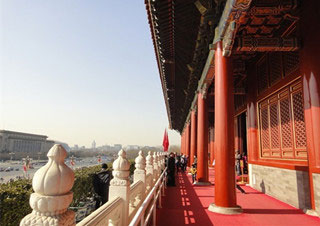 painted red. Also called the Gate of Heavenly Peace, the moat that runs through the Imperial Palace continues along at the foot of the Gate. Five marble bridges span this moat, each leading to one of the five passages you must take to go through the Gate.
painted red. Also called the Gate of Heavenly Peace, the moat that runs through the Imperial Palace continues along at the foot of the Gate. Five marble bridges span this moat, each leading to one of the five passages you must take to go through the Gate.
As you walk towards the Gate, centered on the front wall, is Chairman Mao's portrait. Flanking his portrait, in Chinese characters, are two inscriptions: on the western (left) side, "Long live the People's Republic of China;" on the eastern (right) side, "Long live the great union among the peoples of the world."
Located at the centre of Beijing City, Tian'anmen Gate, literally meaning the Gate of Heavenly Peace, was first built in the 15th year under the reign of Emperor Yong Le of the Ming Dynasty (1417), and was named as Chengtian Gate at that time, meaning that the authority of emperor is conferred by heaven, orders from the day. After expanded in the 8th year under the reign of Shun Zhi of the Qing Dynasty (1651), it was renamed as Tian'anmen Gate. The new name not only covers the meaning of former one, but contains the peace and security of the country. In the Ming and Qing dynasties, Tian'anmen Gate (tower), 33.87 metres high at that time, is the front entrance of the Forbidden City with two stories and five portals as well as nine segments from east to west (wide) and five compartments from south to north (deep). The number of Nine & Five symbolizes the venerability of emperors. Tian'anmen Gate was brought into use at the time of great celebrations such as emperor issuing instructions to his subjects, royal wedding, new emperors ascending the throne, and emperor's parent entering the Forbidden City. For centuries the passages through the Gate remained closed. Opened only on great ceremonial occasions, the center passageway was always reserved for the emperor. Kept closed until the early part of the twentieth century, the Gate is now open and an impressive entrance to the Imperial Palace and its surrounding grounds.
After rehabilitation in 1970, Tian'anmen Gate was raised to 34.7 meters. It is a typical way of traditional Chinese architecture. On October 1, 1949, Chairman Mao Zedong declared the founding of the People's Republic of China on Tian'anmen Gate, and hoisted the first Five-Starred Red Flag in person. From then on, Tian'anmen Gate becomes a symbol of new China. Its solemn figure is taken as an important part of the national emblem. Now, it is a national cultural heritage under special protection.
Visitors may notice that there are two lions standing in front of the gate and two more guarding the bridges. They are, as the same in Europe; symbols of power though they look a bit different from the European image of lions. While admiring the hons, don't miss the two stone columns beside the lions. They are not just ornaments but unique to China and important in m- perial times. In Chinese they are called Huabiao(华表) meaning carved orna- mental columns. Huabiao have a long history in China and many interesting stories are told about them. It was said that in ancient China one of the sage kings by the name of Yao set up a wooden pillar on which people could carve their criticisms of officials, show- ing his willingness to accept the views of the common people. This was the pred. ecessor of huabiao. Huabiao was later used as boundary markers, tombstones and road signs
The marble stone huabiao at Tian'anmen each weigh ten tons. On the top is a round basin for collecting dew on which squats a stone animal called hon. The animal faces south garing at heav. en, and its duty was to watch over the emperor's conduet when he was out. If the emperor was away for too long, the animals would say,"O ruler of the country, do not indulge yourself outside, but return to administer the state. Our eyes are strained awaiting your return." In- side Tian'anmen Gate, there are another two huabiao of the same size. The ani- mals on these two had different roles. They are looking north towards the pa- lace, watching the emperor's conduet inside. They admonished him,"O ruler, do not always keep within the palace, enjoying the company of your empress and concubines, but go out and learn about the miseries of the common peo- ple. Our eyes are strained awaiting your emergence." At the base of each huabiao are marble balustrades, around which are four lions in pairs, male on the left and female on the right.
In front of Tian'anmen is Tian'anmen Square which measures 500 metres from east to west and 880 metres from north to south and covers an area of 50 hectares. It is probably one of the largest squares in the world. The square was built in 1958, and before that and in the Qing Dynasty the place where today's square les was offices of different min- istries and government departments with a wide road running south from the tower.
The square is usually full of people, especially on holidays. Most of them are visitors to Beijing, taking pictures with Tian'anmen as the background, but Bei- jingers bring their children to fly kires in the vast open square. Between the gate tower and the square runs Chang'an Avenue, five kilometres long from east to west. Around the square stand the Great Hall of the People, the Museum of Chinese History, the Museum of the Chinese Revolution, the Memorial Hall of Chairman Mao Zedong, and the Monument to the People's Heroes.
From here people may also visit the three major market streers in Beijing —Wangfujing in the east, Xidan in the west and Dashilan in the south.
The Great Hall of the People, located on the 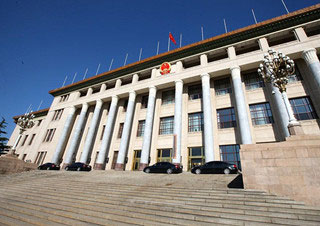 west side of Tian'anmen Square, covers an area of 560,000 sq. ft. (51,520 sq. m.). It is an important place where the state and various mass organizations hold political, diplomatic and social activities, and is also the head office of the Standing Committee of the National People's Congress. As one of Top Ten Buildings in Beijing during ten years of founding new China, the Great Hall of the People, facing the east, is 336 metres long from south to north, 206 meters wide from east to west, and 46.5 meters high with a floor area of 171,800 square meters. Its architectural style is solemn, grand, splendid and elegant with distinctive national features. Over the main gate hangs a spangling national emblem. The structure combines the architectural styles of national structures and modern structures, i.e. solemn, magnificent, simple and elegant.
west side of Tian'anmen Square, covers an area of 560,000 sq. ft. (51,520 sq. m.). It is an important place where the state and various mass organizations hold political, diplomatic and social activities, and is also the head office of the Standing Committee of the National People's Congress. As one of Top Ten Buildings in Beijing during ten years of founding new China, the Great Hall of the People, facing the east, is 336 metres long from south to north, 206 meters wide from east to west, and 46.5 meters high with a floor area of 171,800 square meters. Its architectural style is solemn, grand, splendid and elegant with distinctive national features. Over the main gate hangs a spangling national emblem. The structure combines the architectural styles of national structures and modern structures, i.e. solemn, magnificent, simple and elegant.
Comprised of many rooms and reception areas, it has an auditorium-cum-theater large enough to seat 10,000 people. Its banquet hall has a capacity of 5,000 people, and it was here that Richard Nixon, the first American President to visit the People's Republic of China, was honored with a banquet.
On the east side of the Square, directly across from the Great Hall of the People, you will find these museums housed in one building. The Museum of History, in the right wing, begins with primitive man (500,000 B.C.) and traces China's development up to 1840. The Museum of the Chinese Revolution, in the left wing, covers China's history since the Opium War of 1840 to the present, with particular emphasis on revolution and the establishment of socialism.
Standing in the centre of the square, the monument 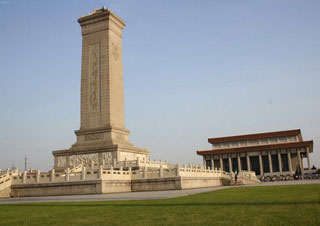 honours those who sac- rificeed their lives for national independ- ence and wars against foreign agression. Rising 14.7, metres high. the granite obelisk looks magnificent. With its double-terrace base, the monument is altogether 37.4 metres high. Irs construction was srarted in 1952 and com- pleted in 1958. In harmony wth the imperial architecture it faces, the monu- ment is in the traditional Chinese style with marble balustrades and decorative carvings. On the ftont is an inscription in gold by the late Chaitman Mao Zedong:"Eternal glory to the people's her- oes", and on the back is the handwriting of the late Premier Zhou Enlai. Carvings at the bottom of the obelisk show major events from different perods of Chinese history.
honours those who sac- rificeed their lives for national independ- ence and wars against foreign agression. Rising 14.7, metres high. the granite obelisk looks magnificent. With its double-terrace base, the monument is altogether 37.4 metres high. Irs construction was srarted in 1952 and com- pleted in 1958. In harmony wth the imperial architecture it faces, the monu- ment is in the traditional Chinese style with marble balustrades and decorative carvings. On the ftont is an inscription in gold by the late Chaitman Mao Zedong:"Eternal glory to the people's her- oes", and on the back is the handwriting of the late Premier Zhou Enlai. Carvings at the bottom of the obelisk show major events from different perods of Chinese history.
Opened in 1977 this imposing building is a tribute to Chairman Mao (1893-1976). Erected between the Monument to the People's Heroes and Qian Men Gate, twin roofs are supported by majestic granite pillars. Materials were gathered from all over China and construction took only ten months to complete.
In the first room there is a commemorative statue of 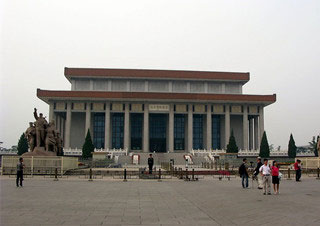 Mao sculptured out of white marble. The second room, called the Chamber of Reverence, contains the remains of Chairman Mao preserved in a crystal coffin. People from all parts of China come here to pay their respects. In the final room of this mausoleum you will find a sample of Mao's calligraphy inscribed on a large marble screen. As you leave the Memorial Hall you will have a good view of Qian Men Gate from the rear terrace.
Mao sculptured out of white marble. The second room, called the Chamber of Reverence, contains the remains of Chairman Mao preserved in a crystal coffin. People from all parts of China come here to pay their respects. In the final room of this mausoleum you will find a sample of Mao's calligraphy inscribed on a large marble screen. As you leave the Memorial Hall you will have a good view of Qian Men Gate from the rear terrace.
Although the Memorial Hall is open to the public, visiting hours are restricted. When you arrive in Beijing be sure to check the current schedule of days and hours the Hall is open so you won't be disappointed and miss seeing it.
At the rear of the Memorial Hall of Chairman Mao, on the southern edge of Tian’anmen Square, one will find Qian Men Gate. Originally the Imperial City was protected by nine gates of which Qian Men is one of the few remaining. Constructed in the fifteenth century, this Gate was recently restored.
As a protective measure the nine original gates were de-signed with two doors or gates and space in between (some-times referred to as double gates). If a hostile force managed to get through the outer or first door, a small enclosure or courtyard would still have to be crossed to get to the inner or second door which led into the City. Towers were strategically placed over these inner doors to allow almost perfect aim at the enemy trapped below.
One should not confuse the terms Imperial City and For-bidden City (Imperial Palace). The Imperial City as it existed many years ago covered an area which encompassed not only the land where the Forbidden City is today, but also Tian’anmen Square and acres and acres of surrounding areas. Anyone who worked in the Imperial Palace lived within the walls of the Imperial City. Much of the original wall has been torn down and is now part of suburban Beijing. Qian Men Gate is one of the last vestiges marking the old Imperial City's boundaries.
China National Museum was established by the combination of Chinese History Museum and Chinese Revolutionary Museum on February 28, 2003. The earliest body of the Chinese History Museum was the Preparatory Office for National History Museum founded on July 9, 1912, which was renamed as the National Beijing History Museum on October 1, 1949 when the People's Republic of China was founded, and renamed once again as the Chinese History Museum in 1959. Chinese Revolutionary Museum, previously the Preparatory Office for National Revolutionary Museum founded in August 1958, was officially established in 1960. Since Chinese History Museum and Chinese Revolutionary Museum were built in August 1958, they had been playing the role of China National Museum.
After expansion, the floor area of China National Museum is increased from 65,000 square meters (total area of Chinese History Museum and Chinese Revolutionary Museum) to 150,000 square meters. According to envisioned plan, a huge National Museum building complex will be built at the east side of Tian'anmen Square to completely exhibit the brilliant history of Chinese nation, development process of "the state, and considerable achievements of Chinese revolution, construction and reform & opening. China National Museum will grow to be the nation's leading integrated museum with the functions of relic collection, archaeology, study and exhibition, to match with the long-standing civilization of Chinese nation.
Tian'anmen Tower was used in the Ming and Qing dynasties to issue imperial edicts First, the Minister of Rites would receive ihe edict in the Taihedian (太和殿Hall of Supreme Harmony) inside the palace, place it on a "cloud tray", raise 1he imperial yellow umbrella above it and thus proceed through Taihemcn ( 太和门 Gate of Supreme Harmony). Then he would put the tray in a miniature "dragon pavilion", which would be carried through Wurnen (午门 Medialion Gale) to the stand set up on Tian'anmen Tower. There the edict would be read out aloud by an edict-proclaiming official. The civil and military officials of the court, lining up according fo rank south of the Outer Gold Water River Bridges, would kneel down facino north towards the empeior. The edict would then be put in the mouth of a gilded wooden phoenix which was lowered by rope (or, during the Ming Dynasty, carried in the mouth of a dragon head on top of a pole) fo a "cloud trayc held below by an official of the Ministry of Rites Again it would be put rn a miniature "dragon pavilion" and carried to the Ministry of Rites beneath an imperial yellow umbrella Then the edict would bo copied oul on yellow paper and sent around the country to be made known to the public This procedure was called "the golden pnoenix issues an edict".